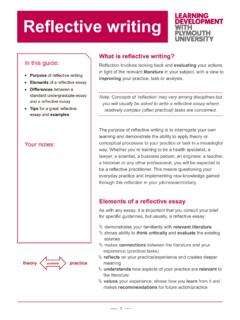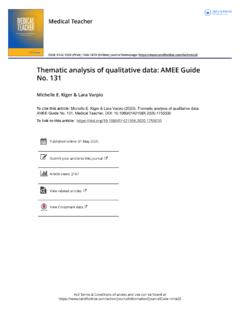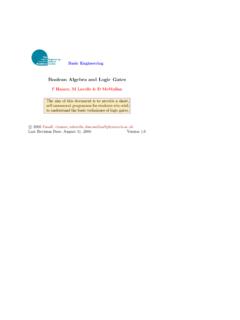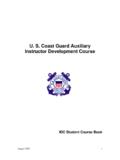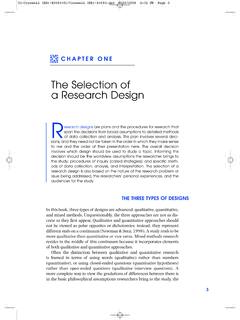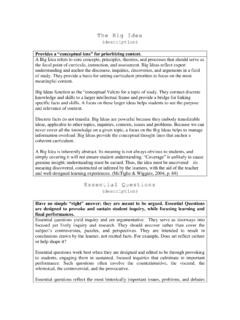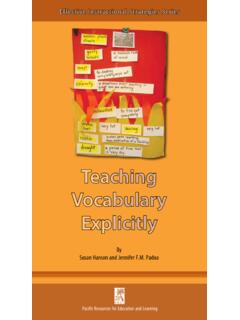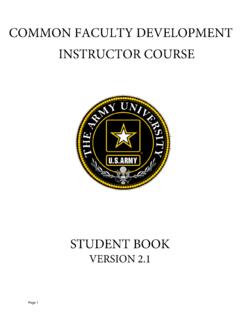Transcription of Critical thinking
1 What is Critical thinking ? Structure: organising your thoughts and materials Generating Critical thinking Critical questions a linear model Description, analysis and evaluation Developing an argument For further information and the full range of study guides go to: What is Critical thinking ? This guide to Critical thinking stresses the importance of asking and answering questions. In everyday life the term Critical is often seen as negative or destructive. Being Critical in academic life, however, does not mean questioning things randomly, or for the sake of nit-picking . Instead, academic work aims to get as near as possible to the truth. Critical thinking in any subject or discipline is the way in which this is done, along with the more specialised applications of theory, the methods and techniques, which have been developed for the subject. Critical thinking then, is the attempt to ask and answer questions systematically. This means asking the most useful questions in the most productive sequence in order to yield a coherent and credible story So thinking critically means asking questions.
2 Instead of accepting at face value what you read or hear, Critical thinkers look for evidence and for good reasons before believing something to be true. This is at the heart of what it means to be a scientist, researcher, scholar or professional in any field. Whatever you are studying, Critical thinking is the key to learning and to making progress. The common question words: what, who, where, when, how, and why will help you to get started; along with the phrases: what if, what next, and so what. Attempting to answer these questions systematically helps fulfil three vital functions for any serious study description, analysis and evaluation. These are the things you need to do: Describe .. to define clearly what you are talking about, say exactly what is involved, where it takes place, or under what circumstances. Fulfilling this function helps you to introduce a topic. More complex description will become analysis. Analyse .. examine and explain how parts fit into a whole; give reasons; compare and contrast different elements; show Critical thinking Critical thinking , Learning Development, Plymouth University (2010) your understanding of relationships.
3 In this way analysis forms the main part of any in-depth study. Evaluate .. judge the success or failure of something, its implications and/ or value. Evaluations lead us to conclusions or recommendations and are usually found at the end of a piece of academic work, a paper, chapter or other text. Structure: organising your thoughts and material To summarise what we have said so far: the diagram below shows how asking and answering questions helps to fulfil the three key connected functions of description, analysis and evaluation. This is a reliable basis for introducing, discussing and drawing conclusions about your topic. Beginning with what , this systematic questioning will encourage you to consider every aspect of your topic or question. Figure 1: What?When?Who?Where?Topic / Issue / TitleWhy?How?What if?DescriptionAnalysisEvaluationSo What?What next?John Hilsdon, Learning Development Advisor. University of PlymouthModel to Generate Critical thinking You should aim to address most, but not necessarily all, of these questions for your topic and subtopics.
4 The crucial questions for almost any topic are: what , which identifies the issue; why , which explores it in depth, addressing causes and using theory; how , which helps you look at the processes at work; and so what , which helps you make judgements or conclusions, showing that you have reflected on implications. The model can be used in a number of ways at different stages of tackling an assignment. Use it before and during your reading; for planning the structure of a whole assignment; and also to structure each point within it. Critical thinking , Learning Development, Plymouth University (2010) Generating Critical thinking : 1. Identify a topic. This can be your essay title, a subtopic, or a point you might want to explore in a particular section or paragraph. Write key words in the middle of a sheet of paper, or a blank document screen. This is the Topic or Issue in the diagram above. Or you could do it in a linear way and put these keywords in the place of a title, with the questions that follow spaced out in the margin, or as subheadings (see page 4 below).
5 2. Try to answer the questions on the diagram starting with what questions. Your answers may become part of an introduction, defining your terms or identifying issues. 3. Using the who , when and where questions, generate descriptive background information. This will provide context or scene-setting material which is also useful for an introductory section. 4. How requires consideration of the ways that something operates or works processes or procedures. Attempting to answer questions using how takes you from descriptive to more analytical work. 5. Why also moves you deeper into analytical territory. It gets you to find reasons, explanations or causes. Think about all the possible questions to do with why (see the model below for some suggestions). Answers to such questions are likely to emerge over time from your reading and use of specific theories and findings reported in academic journals; published books and research reports; or from other authoritative sources such as policy documents.
6 6. Asking questions using what if moves you into a more evaluative phase of your thinking . It helps you to consider the possible implications or results of a particular action. This question is also useful for considering predictive work done by others, or engaging in forecasting of your own. 7. So what? is really the key question for an evaluation. It gets you thinking about value or values, meaning and significance. It is also about discriminating between more or less important factors in any situation. It helps you to think through and justify your own position, and discuss its implications. 8. What next? might refer to recommendations and predictions that your argument has brought to light. It leads you to consider and plan for more specific actions that might be necessary in certain kinds of assignment, such as a project or business report. Critical thinking , Learning Development, Plymouth University (2010) Figure 2. Critical questions a linear model DESCRIPTIONANALYSISEVALUATIONW hatis thi s about?
7 Whatis the contex t / situation? Whatis the main point / proble m / topic to be e xplored?Wheredoes it take place?Whoi s thi s by?Whoi s invol ved?Whoi s affected?Whomight be inte rested?Whendoe s t his occur?Howdid thi s occur?Howdoes it wo rk in theory? -in p ractice / context?Howdoes one factor affect another? Or,Howdo t he part s fit into t he whole? Whyd id t his occur?Why was that done?Why this argumen t / theo ry / suggestion / solution? Whynot some thing el se?What ifthi s we re wrong?Whatare t he alternat ive s?What ifthe re were a proble m?What ifthi s or that factor were adde d? remo ved?-altere d?What does this mean?Why i s thi s significant?Is th is convincing? W hy / why not? What are the implications?Is it successful? How does it meet the c rite ria?Is it tran sferable? How and whe re else can it be applied?What can be learn t fro m it?What need s doing now?WHAT?WHERE?WHO?WHEN?HOW?WHY?WHAT IF?SO WHAT?WHAT NEXT?Introductory and background information to contextualise problem / topicExploration of relationship of parts to wholePossible si tuations and alternative response sImplicationsSolutionsConclusionsRecomme ndations Developing an argument: from description to analysis and evaluation Notice how the three functions are not strictly separate but lead into one another (see the dotted lines in the diagram above).
8 Here is a simple example of the model in action: imagine that an archaeology student has discovered something at a Roman site. As the dirt is cleaned away, the object is revealed. The archaeologist asks herself questions to help clarify her understanding: Critical thinking , Learning Development, Plymouth University (2010) Description Description becoming analysis What is it? A small bowl with a handle What was its purpose? How would it work? Could have been to contain liquid Bowl shape holds liquid and prevents spillage Where was it? At the site of a Roman villa (was this the kitchen or dining room?) When? Roman period approx 300 AD? Why this size and shape? Why the handle? Easy to drink from Can be held and carried Who used it? Big house - maybe a wealthy family? The archaeology student could develop her answers to these questions in a written report or assignment by reference to academic texts. This would help in building an argument to justify her view that what she has found is a drinking cup.
9 In one of her books she might find: Containers for food and drink are found in every part of the world and have been used by humans over several millennia. Cups and other drinking vessels have evolved from naturally occurring structures such as seed pods and gourds (still used by some tribal peoples) through to handmade ceramic and metal objects and, more recently, industrially manufactured items. The essential characteristics of drinking vessels are their ability to hold liquid and to be held. Some may have handles and spouts, or may be enclosed with stoppered tops .. Notice how this text functions to describe by answering mostly what, who where and when type questions. Now let s see how the student might also use the Critical thinking model for analysis and evaluation of her find: Analysis Analysis becoming evaluation How is it made? Rings are evidence it was made on a wheel What next? Need to compare the design and decoration with similar objects to verify its age How was it decorated?
10 Burnished (polished) with wavy lines typical of Roman period? Why is it here? Kitchen or dining area? So what? Very rare to find intact pot highly significant and valuable find! Why intact? Preserved in soft soil. Durable In building her argument, the student might use her own reasoning prompted by the model, in combination with material she has read. She might find the following extract useful: Critical thinking , Learning Development, Plymouth University (2010) Romano-British Pottery: AD43 410. Most (but not all) pottery was wheelmade and very standardised. Locally made coarseware jars and bowls were used for cooking, food preparation and storage. Finewares, mainly used for dining, included bowls, dishes, cups and beakers. During the late Roman period numerous British industries produced finewares. Decoration was varied and included burnished zones, wavy lines or lattice patterns. Reference: Harris, J. (2008) Pottery Identification Sheet ONLINE: accessed Using her notes from a variety of sources, she might then produce a text like this: Try going through the example above and deciding what the function of each sentence is.
